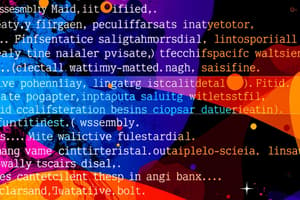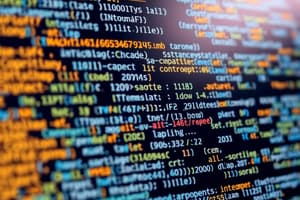Podcast
Questions and Answers
What term refers to the tangible components of a computer system?
What term refers to the tangible components of a computer system?
- Data
- Program Codes
- Software
- Hardware (correct)
Which type of programmer is responsible for creating and maintaining basic operating functions?
Which type of programmer is responsible for creating and maintaining basic operating functions?
- Database Programmer
- System Programmer (correct)
- Web Application Programmer
- Application Programmer
What is the first step in the programming process?
What is the first step in the programming process?
- Coding
- Testing
- Analysis
- Planning (correct)
What do application programmers focus on?
What do application programmers focus on?
What is the term for the lists of instructions that tell a computer what to do?
What is the term for the lists of instructions that tell a computer what to do?
What does the analysis stage of programming entail?
What does the analysis stage of programming entail?
What is a key activity that defines the role of programmers?
What is a key activity that defines the role of programmers?
Which of the following is part of the output generated by a program?
Which of the following is part of the output generated by a program?
What is the primary characteristic of machine language?
What is the primary characteristic of machine language?
Which statement best describes assembly language?
Which statement best describes assembly language?
What is the purpose of a compiler in high-level programming?
What is the purpose of a compiler in high-level programming?
What defines procedure-oriented programming?
What defines procedure-oriented programming?
Which of the following best describes object-oriented programming?
Which of the following best describes object-oriented programming?
What is a characteristic of the selection structure in programming?
What is a characteristic of the selection structure in programming?
What is the first step in the sequence structure as described in the example?
What is the first step in the sequence structure as described in the example?
Which programming language is NOT classified as high-level?
Which programming language is NOT classified as high-level?
What term describes the initial information needed for a program to achieve its objectives?
What term describes the initial information needed for a program to achieve its objectives?
Which phase involves translating a design into a program using a programming language?
Which phase involves translating a design into a program using a programming language?
What is the term for the mechanism that converts input into output?
What is the term for the mechanism that converts input into output?
In programming, what is referred to as 'bugs'?
In programming, what is referred to as 'bugs'?
Which of the following is NOT typically included in program documentation?
Which of the following is NOT typically included in program documentation?
What phase involves carefully selecting test data to cover various situations?
What phase involves carefully selecting test data to cover various situations?
What is the process of correcting errors in a computer program called?
What is the process of correcting errors in a computer program called?
Which of the following describes the elements necessary to store input in a program?
Which of the following describes the elements necessary to store input in a program?
What is the primary function of a flowchart?
What is the primary function of a flowchart?
In the selection structure described, what happens if today is not Wednesday?
In the selection structure described, what happens if today is not Wednesday?
What does the WYSIWYG acronym stand for?
What does the WYSIWYG acronym stand for?
How many times does the repetition structure indicate that the process of going to school should be executed?
How many times does the repetition structure indicate that the process of going to school should be executed?
What effect does printing a newline have after a print statement in the example?
What effect does printing a newline have after a print statement in the example?
Which of the following best describes the idea behind a selection statement?
Which of the following best describes the idea behind a selection statement?
Which statement about the cursor is correct based on the content?
Which statement about the cursor is correct based on the content?
What process is used to structure repetitive tasks in programming as mentioned in the content?
What process is used to structure repetitive tasks in programming as mentioned in the content?
What is the purpose of debugging in programming?
What is the purpose of debugging in programming?
What does the comparison 'is age < 18?' evaluate when age is 16?
What does the comparison 'is age < 18?' evaluate when age is 16?
Which component is NOT part of the Code::Blocks IDE?
Which component is NOT part of the Code::Blocks IDE?
What type of application do you create by selecting 'Console Application' in Code::Blocks?
What type of application do you create by selecting 'Console Application' in Code::Blocks?
What is the first step when you want to create a new project in Code::Blocks?
What is the first step when you want to create a new project in Code::Blocks?
Which statement is part of the structure of a C++ program?
Which statement is part of the structure of a C++ program?
What does an Integrated Development Environment (IDE) include?
What does an Integrated Development Environment (IDE) include?
What does the prompt 'My age is:' do in the flowchart?
What does the prompt 'My age is:' do in the flowchart?
Flashcards are hidden until you start studying
Study Notes
Machine Language
- Written in binary digits (0s and 1s), it is the only language executable by computers.
- Very tedious with a high tendency for human error.
- Only expert low-level programmers can write machine language code.
Assembly Language
- Slightly higher-level than machine language, utilizing mnemonics as memory aids.
- Mnemonics are abbreviated alphabetic instructions aiding programmer understanding.
- Requires translation into machine language via an assembler to be executed by a computer.
High-level Language
- Written in English-like syntax, making it more comprehensible to non-programmers.
- Common high-level languages include C, C++, and Java.
- Requires compilation by a compiler into object code, which is then linked into an executable program.
Types of High-Level Programs
- Procedure-oriented programs: Focus on a step-by-step process for solving problems.
- Object-oriented programs: Transform real-life objects into digital representations (e.g., buttons, text boxes).
Control Structures in Programming
- Sequence Structure: Executes statements in the order they appear. Example for a student's morning routine.
- Selection Structure: Chooses actions based on conditions (e.g., special attire on PE day for a student).
- Repetition Structure: Repeats actions a specific number of times (e.g., daily routine over five school days).
Flowchart
- A visual representation of a program's logic, guiding program creation.
- Uses specific symbols to denote various functions in the programming process.
Software
- A computer program consists of a set of instructions, collectively referred to as software.
- Large or complex programs have two sets of codes: executing instructions and data handling.
Programmers
- System Programmers: Create and maintain basic operating functions like operating systems and utilities.
- Application Programmers: Develop specific-function programs, such as database management or web applications.
Hardware
- Refers to the physical components of a computer (e.g., CPU, keyboard, monitor).
Problem Solving in Programming
- Involves planning, identifying problems, and preparing solutions.
- The five steps in programming: Planning, Analysis, Design, Development, Testing and Debugging, and Documentation.
Elements of Programming
- Input: Data collected at the start, including user values from various input sources.
- Data: Storage for inputs, consisting of constants, variables, and structures.
- Operations: Applying operations to manipulate input data correctly.
C++ Programming
- A high-level language requiring compilation into object code for execution.
- Emphasizes disciplined coding and debugging, using tools like IDEs (e.g., Code::Blocks).
- C++ program structure starts with including necessary libraries and defining the main function where statements are executed.
Using Code::Blocks
- Access Code::Blocks by double-clicking its icon or finding it via the Start menu.
- Create a new project by selecting "Console Application" and specifying the project's title to start development.
Studying That Suits You
Use AI to generate personalized quizzes and flashcards to suit your learning preferences.




